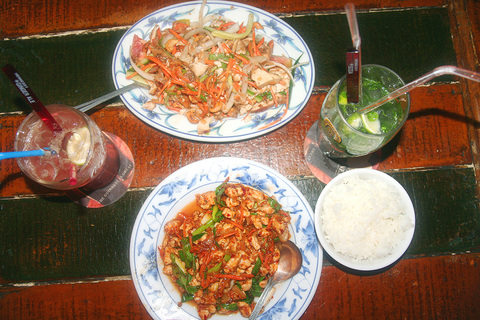It was a Sunday afternoon in Kenting (墾丁) and tourists were fleeing the Pingtung County (屏東縣) hotspot to avoid getting trapped by the approaching typhoon.
A perfect opportunity, it seemed, had presented itself to check out Warung Didi. On several previous visits the Taipei Times had been rebuffed by the famed purveyor of “a world of exotic cuisines,” as it was fully booked.
So this time around we did as we were told and called promptly at 4pm for reservations that night. The phone was constantly engaged and the restaurant was reserved by the time we got through an hour later.

PHOTO: JULES QUARTLY, TAIPEI TIMES
Fortunately (to cut a long review short) there had been a cancellation at 11:20pm. Last orders would be ours. And that is how we eventually came to review the culinary landmark founded by Di Di Yi (易迪迪) some 14 years ago.
The drinks list was a good start, with a thoughtful range of cocktails, beers, wines and nonalcoholic beverages. Though our mojito and mai tai (dubbed “my tai tai,”) were served up quickly, at full strength and with fresh ingredients, their arrival in Boddingtons and Coca-Cola glasses was a little surprising.
The menu was conveniently divided into sections, such as “the chicken coop” for poultry dishes, “soup pot,” “ok corral” for beef, seafood was “the waterfront.”
We plumped for Thai boneless chicken in basil sauce and Patpong chicken salad with shrimp dressing. They were zesty affairs but a degree too hot for our taste.
Most of the main dishes were priced from NT$250 to NT$340 and the cheesecake (NT$100), made daily, was wickedly rich, piqued by lemon and caramelized on top. Clearly, fresh food served in fair-sized portions, at a reasonable cost is one of the reasons for Warung Didi's popularity.
Atmosphere is also essential. If a place feels good you want to go back. Located off the high street and near the beach, Warung Didi was bathed in fairy lights, miniature red lanterns and ambient music. The interior was tastefully decorated in wood, with Indian/Aboriginal designs and an eclectic mix of old prints and batik paintings.

May 11 to May 18 The original Taichung Railway Station was long thought to have been completely razed. Opening on May 15, 1905, the one-story wooden structure soon outgrew its purpose and was replaced in 1917 by a grandiose, Western-style station. During construction on the third-generation station in 2017, workers discovered the service pit for the original station’s locomotive depot. A year later, a small wooden building on site was determined by historians to be the first stationmaster’s office, built around 1908. With these findings, the Taichung Railway Station Cultural Park now boasts that it has

The latest Formosa poll released at the end of last month shows confidence in President William Lai (賴清德) plunged 8.1 percent, while satisfaction with the Lai administration fared worse with a drop of 8.5 percent. Those lacking confidence in Lai jumped by 6 percent and dissatisfaction in his administration spiked up 6.7 percent. Confidence in Lai is still strong at 48.6 percent, compared to 43 percent lacking confidence — but this is his worst result overall since he took office. For the first time, dissatisfaction with his administration surpassed satisfaction, 47.3 to 47.1 percent. Though statistically a tie, for most

In February of this year the Taipei Times reported on the visit of Lienchiang County Commissioner Wang Chung-ming (王忠銘) of the Chinese Nationalist Party (KMT) and a delegation to a lantern festival in Fuzhou’s Mawei District in Fujian Province. “Today, Mawei and Matsu jointly marked the lantern festival,” Wang was quoted as saying, adding that both sides “being of one people,” is a cause for joy. Wang was passing around a common claim of officials of the People’s Republic of China (PRC) and the PRC’s allies and supporters in Taiwan — KMT and the Taiwan People’s Party — and elsewhere: Taiwan and

Six weeks before I embarked on a research mission in Kyoto, I was sitting alone at a bar counter in Melbourne. Next to me, a woman was bragging loudly to a friend: She, too, was heading to Kyoto, I quickly discerned. Except her trip was in four months. And she’d just pulled an all-nighter booking restaurant reservations. As I snooped on the conversation, I broke out in a sweat, panicking because I’d yet to secure a single table. Then I remembered: Eating well in Japan is absolutely not something to lose sleep over. It’s true that the best-known institutions book up faster